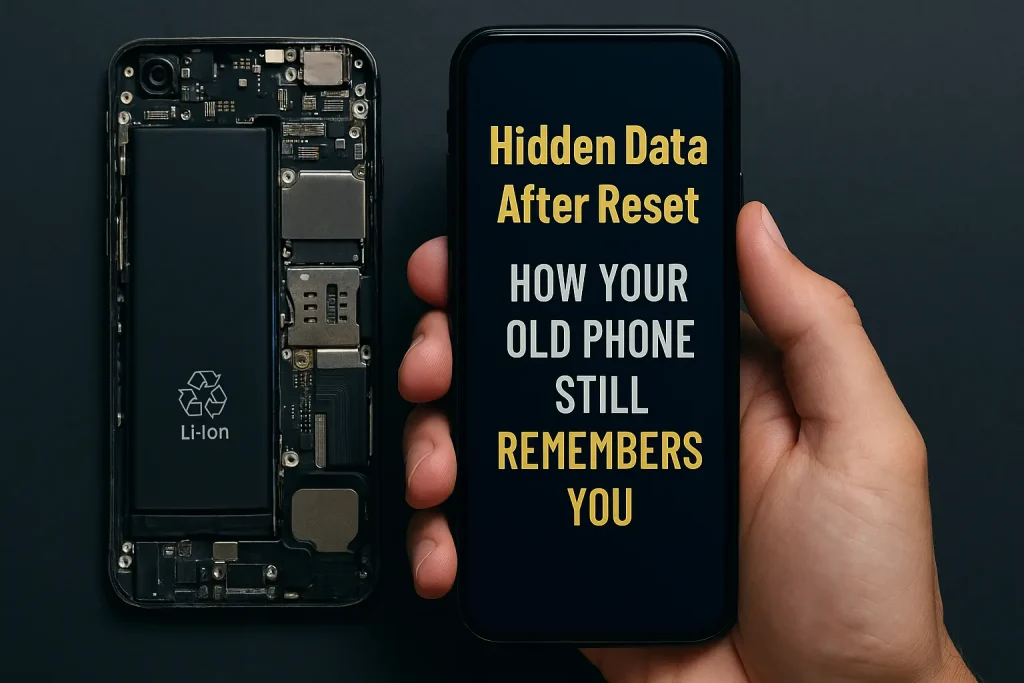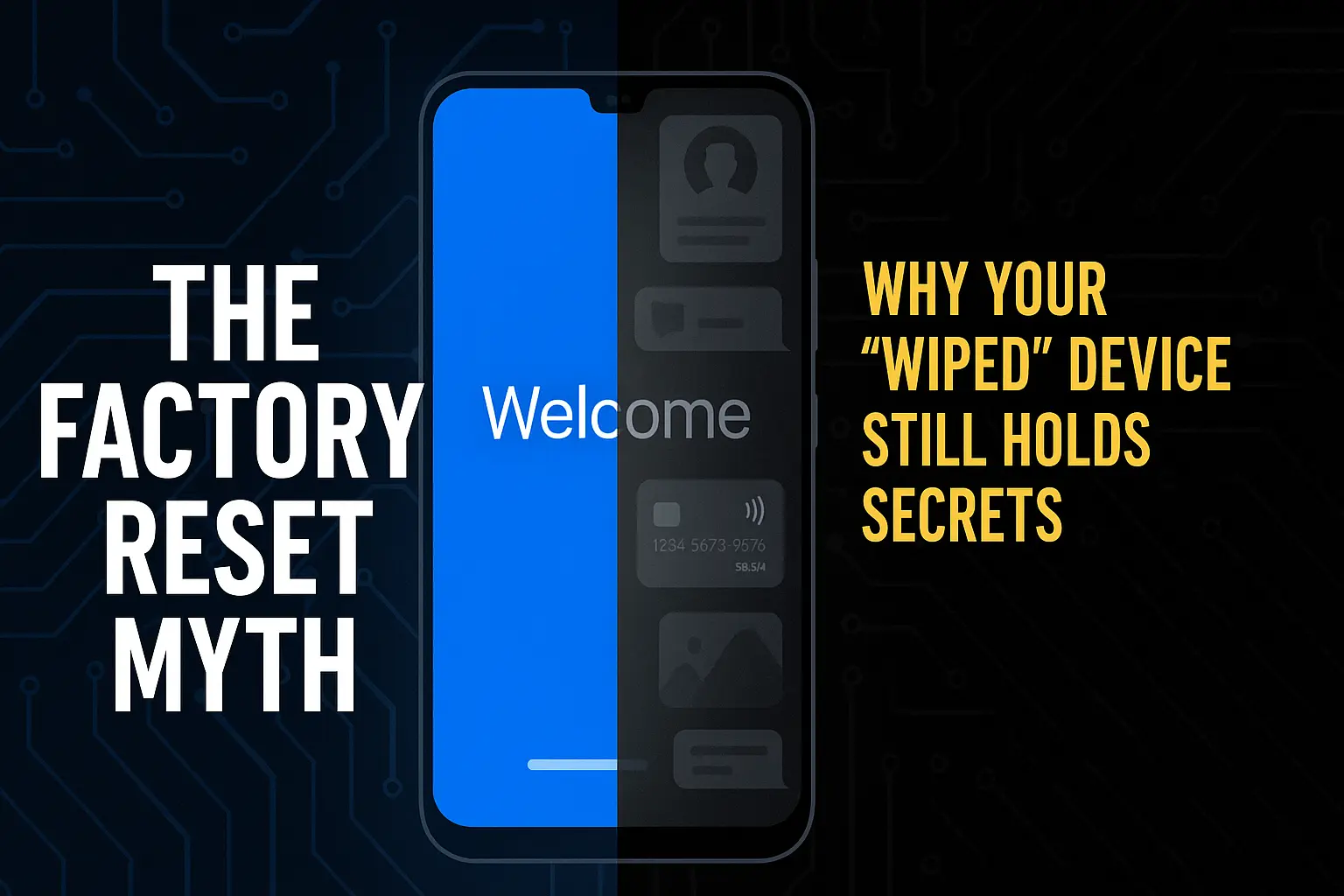A factory reset is often seen as the “magic button” that erases everything on a device. Many people perform it before selling or recycling an old phone, laptop, or tablet, assuming their personal information is gone forever. The truth is more complicated.
A factory reset restores default settings and clears visible files, but remnants of sensitive data often remain hidden in memory sectors, caches, or backups. With the right tools, fragments of your photos, messages, and financial details can be recovered, putting your privacy at risk.
Understanding Factory Reset
A factory reset is designed to return a device to its original manufacturer settings. It removes apps, user data, and personal configurations, giving the impression of a “clean slate”. It is widely used for troubleshooting, resale, or recycling devices.
However, factory resets do not guarantee total data erasure. Instead of overwriting all storage areas, they mostly remove file pointers. The actual data blocks often remain intact until overwritten by new files. This means your supposedly “erased” device may still carry traces of sensitive information. It is a similar misconception to when people believe deleting a file means it is gone, something we have previously explained in our post on how to know if your Windows computer is hacked, where invisible processes often leave behind traces users cannot see.
The Myth vs. The Reality
The Myth
“Factory reset wipes everything. My device is brand new again.”

The Reality
- Residual Data: Photos, contacts, and texts can still be recovered using forensic recovery tools like Autopsy or FTK Imager.
- Metadata Persistence: Even after resets, file names, timestamps, and cached thumbnails may remain.
- Hidden Partitions: Many devices have system partitions untouched by a reset, which may still contain user data or malware.
In fact, forensic studies on second-hand devices found bank information, photos, and private messages still recoverable after resets. This risk mirrors the problem of hackers stealing data from Google backups, where users assume a service or process has fully protected them, only to discover critical information is still exposed.
Security Implications
For organizations, the stakes are even higher. A reset laptop handed to a reseller may still contain fragments of intellectual property, employee information, or customer data. For everyday users, it could mean identity theft, fraud, or embarrassing personal exposure.
It is also important to note that some malware survives factory resets by embedding itself into firmware or recovery partitions. Resetting won’t reach these areas, leaving you falsely confident. This is why depending only on one security layer, whether it is a reset, a password, or even 2FA, can be misleading, as we explored in our article on security vulnerabilities and why passwords alone won’t save you.
Data Recovery Methods After Reset
To understand the risk, it is worth noting how data can still be extracted:
- Logical recovery: Uses software to scan and rebuild “deleted” file fragments.
- Physical recovery: Involves accessing damaged or hidden parts of the drive.
- Forensic recovery: Law enforcement and attackers alike use advanced imaging and carving tools to rebuild evidence.
These methods are powerful enough that even after a factory reset, sensitive remnants such as contact lists, messages, and images can reappear. It is the same principle behind many of the latest phishing attacks: users rely on surface-level safety signals, but attackers exploit what is left behind in the background.
Privacy Concerns and Legal Context
The assumption that factory reset = privacy has broader implications. Under modern privacy laws (like GDPR in Europe or CCPA in California), organizations must ensure true data sanitization when disposing of devices. Failure to do so can lead to breaches, regulatory penalties, and reputational harm.
For individuals, selling or donating a phone without properly erasing data may expose them to identity theft or even extortion. We have already seen how attackers exploit private material in sextortion scams, where old files, once thought deleted, are used to pressure victims.
Best Practices for Secure Data Deletion
- Encrypt First, Then Reset
- On iOS, enabling “Erase All Content and Settings” with encryption makes residual data unreadable.
- On Android, use the verified erase option with encryption enabled.
- Use Specialized Wipe Software
- Tools like DBAN, Eraser, or commercial-grade wipe utilities overwrite data sectors multiple times.
- Look for compliance with standards like NIST 800-88 or DoD 5220.22-M.
- Check Your Cloud Accounts
- Before resetting, disable backups and unlink services like Google Drive or iCloud. Otherwise, synced data may remain vulnerable. This is especially important if you’ve ever worried about money disappearing from your bank account without authorization, since leaked financial details often come from improperly cleared devices or cloud links.
- Consider Professional Services
- Certified data destruction providers can physically shred, degauss, or incinerate drives and provide proof of destruction.
- Physical Destruction for Critical Data
- If the stakes are high (corporate or sensitive data), physical destruction of the drive remains the most reliable method.
The factory reset myth creates a dangerous sense of security. While it is a useful step for troubleshooting or preparing devices for reuse, it is not enough to guarantee privacy. Whether you are an individual selling an old phone or an organization retiring hardware, it is crucial to combine resets with encryption, secure wipe tools, or professional destruction services.



